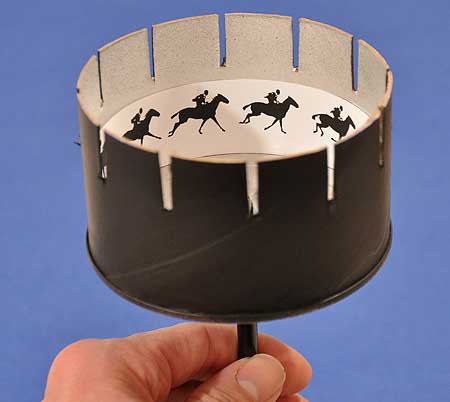Frame Rate for Video – the Basics Explained
Frame rate (fps) – what is this and how does it affect your smartphone shot video?
As you move beyond the automatic settings on your smartphone camera, you will most likely want to start setting your own frame rates.
Put simply, the frame rate is the number of frames your camera shoots per second of filming. You see, film or video are not actually moving images. Even with today’s advanced technology, there is no such thing as a real moving image.
What film and video do is present to the human eye a series of still images which create the illusion of movement. That’s because, after a certain number of still images per second, the human brain starts to interpret it as movement.
Some history
If you go right back to the invention of moving images, with devices such as the Zoetrope, you can see frames and frame rates in action.

The word Zoetrope is composed from the Greek root words ζωή zoe, “life” and τρόπος tropos, “turning” as a transliteration of “wheel of life”. The term was coined by inventor William George Horner.
In the picture above, you can see simple still images of a running horse. When you view the image of the horse and rider through slits in the spinning cylinder, the illusion of a galloping horse is created. Your mind fills in the gaps and the image is animated. And if you speed up or slow down the speed at which you spin the cylinder, you will be changing the frame rate.
Early silent films had stated frame rates anywhere from 16 to 24 frames per second. But since the cameras were hand-cranked, the rate often changed during the scene to fit the mood. Which is an interesting thought, isn’t it? The hand-cranked film camera was more like an expressive musical instrument. Frame rate was controlled directly by human motion.
There was also a difference between the frame rate at which they were filmed and the frame rate they were projected at.
It’s complicated. So, let’s focus on the basics.
What difference does a frame rate make?
The human visual system can process 10 to 12 images per second and perceive them individually, while higher rates are perceived as motion. Remember, when we talk about images per second, we are talking about frame rate.
Over time, 24 frames per second became established as the standard rate movies were shot and projected at. This allows the image to move smoothly whilst at the same time allow some motion blur.
As a side note, I recently bought one of my favourite films, Silent Running (1972), for Andrea on blu-ray. But as we watched the movie on Andrea’s new Samsung TV, the movie did not appear to have aged well. The quality of the image was crisp and clear – but lighting and the 70s sci-fi sets looked terrible! You could almost see the brushstrokes where they’d painted the background – which was supposed to be a spaceship.
I certainly didn’t remember it looking this bad. Had my memory deceived me?
Then I discovered this new technological advance which was being set as default in new TVs. It had become known as the soap opera effect, because it made great films look like cheap soaps.
“The setting on modern TVs that creates and interpolates additional frames in between the existing ones in order to produce a sharp and crisp image of the action taking place on screen. This can come in handy when it comes to fast-paced sports events, but when applied to most narrative work you will find that the silky motion blur that’s so characteristic of cinematic works just disappears. Gone! Wiped out on purpose by your own TV.” Olaf von Voss
So, this is a great illustration of how frame rate affects the look and feel of a moving image.
What frame rate should I choose?
24fps – for many decades now, a standard for movies and TV shows. Even if a film is shot at a higher frame rate, it’s often produced and displayed at 24fps. Most feature films and TV shows are shot and viewed at 24 fps. So when people talk about creating the cinematic film look they suggest 24fps.
30fps – a standard for television and is still widely used, despite producers moving toward a more cinematic 24fps.
Anything higher than 30fps is usually reserved for sports or anything you want to show in slow motion. You see, if you shoot in 60fps and then show those images at 24fps, the motion will be slowed down – and look nice and smooth.
If you record at 24fps, then try to slow down the footage, you will start to get a more jerky motion. Having said that, computers are getting better at “interpolating” new frames between the available ones – which is actually exactly how the “soap opera effect” is created by new TVs.
But what about shutter speed?
Frame rates and shutter speed work together to create the feel of the image. When we are trying to achieve the “film look” with digital cameras, we are trying to copy what developed out of the restrictions of the mechanical process. You know, exposing bits of celluloid to light through a lens.
Normally, when shooting celluloid film at 24fps, the shutter would be open for 1/48th of a second per frame. So it’s this frame rate + shutter speed combo which creates something mimicking the way film looked when projected.
Do you remember how the explosions in Saving Private Ryan (1998) had a more staccato, sharp edges feel? This was achieved by changing the angle of the shutter, and therefore the length of time each frame was exposed. A shutter would normally be at 180 degrees, allowing each frame to be exposed for 1/48th of a second. By changing the angle to 90 degrees or 45 degrees, the time of exposure was reduced.
If the length of time each frame is exposed to light is reduced, there will be less motion blur taking place in each frame.
“By applying 45 degree shutter, we are achieving certain staccato in actor’s movement. We are achieving certain crispiness of explosions. Everything becomes slightly, just slightly more realistic. I used a 45-degree shutter on the explosions, and a 90-degree shutter on most of the running shots. But we alternated at times. Sometimes the 45-degree shutter would appear too exaggerated and the 90 turned out to be better. But for extreme explosions like this, where we really wanted to practically count each individual particle flying through the air, the 45-degree shutter worked best.” Steven Spielberg
You can read this interesting article about it.
Other issues
So, to mimic the look of the way films were shot because that’s the best they could do with the technology at the time, set frame rate to 24 and shutter speed to 1/48 (to mimic the 180 degree shutter angle).
Having said that, I use 25fps and 1/50th because in Europe artificial lights can start to flicker at 24fps. That’s because lights in North America and north of South America flicker at a 60hz frequency, while in Europe, Africa and Asia, it’s 50Hz. This is directly related to the AC current of the particular country.
So you see, 25fps + 1/50th matches 50hz. So, that’s something else to consider. And it’s good to know even digital filmmaking has its practical considerations as well as creative ones.
In most cases, the slightly smudged effect achieved feels nice to look at. This is also why the out of focus background became popular in recent decades.
Hopefully, you will now have a better overall understanding of how frame rates effects the look of your video. To receive more tutorials and news articles, don’t forget to subscribe below.
Eager to learn more?
Join our weekly newsletter featuring inspiring stories, no-budget filmmaking tips and comprehensive equipment reviews to help you turn your film projects into reality!
Simon Horrocks
Simon Horrocks is a screenwriter & filmmaker. His debut feature THIRD CONTACT was shot on a consumer camcorder and premiered at the BFI IMAX in 2013. His shot-on-smartphones sci-fi series SILENT EYE featured on Amazon Prime. He now runs a popular Patreon page which offers online courses for beginners, customised tips and more: www.patreon.com/SilentEye


